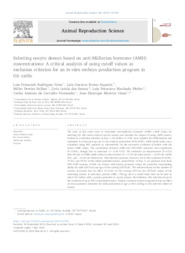Selecting oocyte donors based on anti-Müllerian hormone (AMH) concentrations: a critical analysis of using cutoff values as exclusion criterion for an in vitro embryo production program in Gir cattle.
Selecting oocyte donors based on anti-Müllerian hormone (AMH) concentrations: a critical analysis of using cutoff values as exclusion criterion for an in vitro embryo production program in Gir cattle.
Author(s): FERES, L. F. R.; SIQUEIRA, L. G. B.; PALHAO, M. P.; SANTOS, L. L. dos; PFEIFER, L. F. M.; FERNANDES, C. A. de C.; VIANA, J. H. M.
Summary: The aims of this study were to determine anti-müllerian hormone (AMH) cutoff values for selecting Gir (Bos taurus indicus) oocyte donors and estimate the impact of using AMH concentrations as a selection criterion. In Exp. 1, Gir heifers (n=120) were sampled for AMH analysis and submitted to ovum pick-up and in vitro embryo production (OPU-IVEP). AMH cutoff values were calculated using ROC analysis or, alternatively, by the successive exclusion of heifers with the lowest AMH values. The correlations between AMH and OPU-IVEP outcomes were significant (P<0.001), though low or moderate (r= 0.34–0.52). We estimated an improvement (P<0.05) after the use of AMH cutoff values to select donors of +15.3% for total oocyes, +19.4% for viable COC, and +23.4% for blastocysts. This selection pressure, however, led to the exclusion of 32.8%, 37.9%, and 50.0% of the initial potential donors, respectively. In Exp. 2, we analyzed data from OPU-IVEP sessions of 658 Gir donors with known genomic values for predicted transmitting ability for milk (GPTAm) and age at first calving (GPTAafc). The selection based on the number of oocytes recovered had no effect (P>0.05) on the average GPTAm nor GPTAafc values of the remaining donors. In summary, plasma AMH ?700?pg/mL is a cutoff value that can be used to select Gir heifers with a greater potential as oocyte donors. Nevertheless, this selection leads to the exclusion of up to 50% of potential donors. Finally, exclusion of poor responders had no effect on mean genomic estimates for milk production or age at first calving in the selected subset of donors.
Publication year: 2024
Types of publication: Journal article
Unit: Embrapa Dairy Cattle
Observation
Some of Embrapa's publications are published as ePub files. To read them, use or download one of the following free software options to your computer or mobile device. Android: Google Play Books; IOS: iBooks; Windows and Linux: Calibre.
Access other publications
Access the Agricultural Research Database (BDPA) to consult Embrapa's full library collection and records.
Visit Embrapa Bookstore to purchase books and other publications sold by Embrapa.

